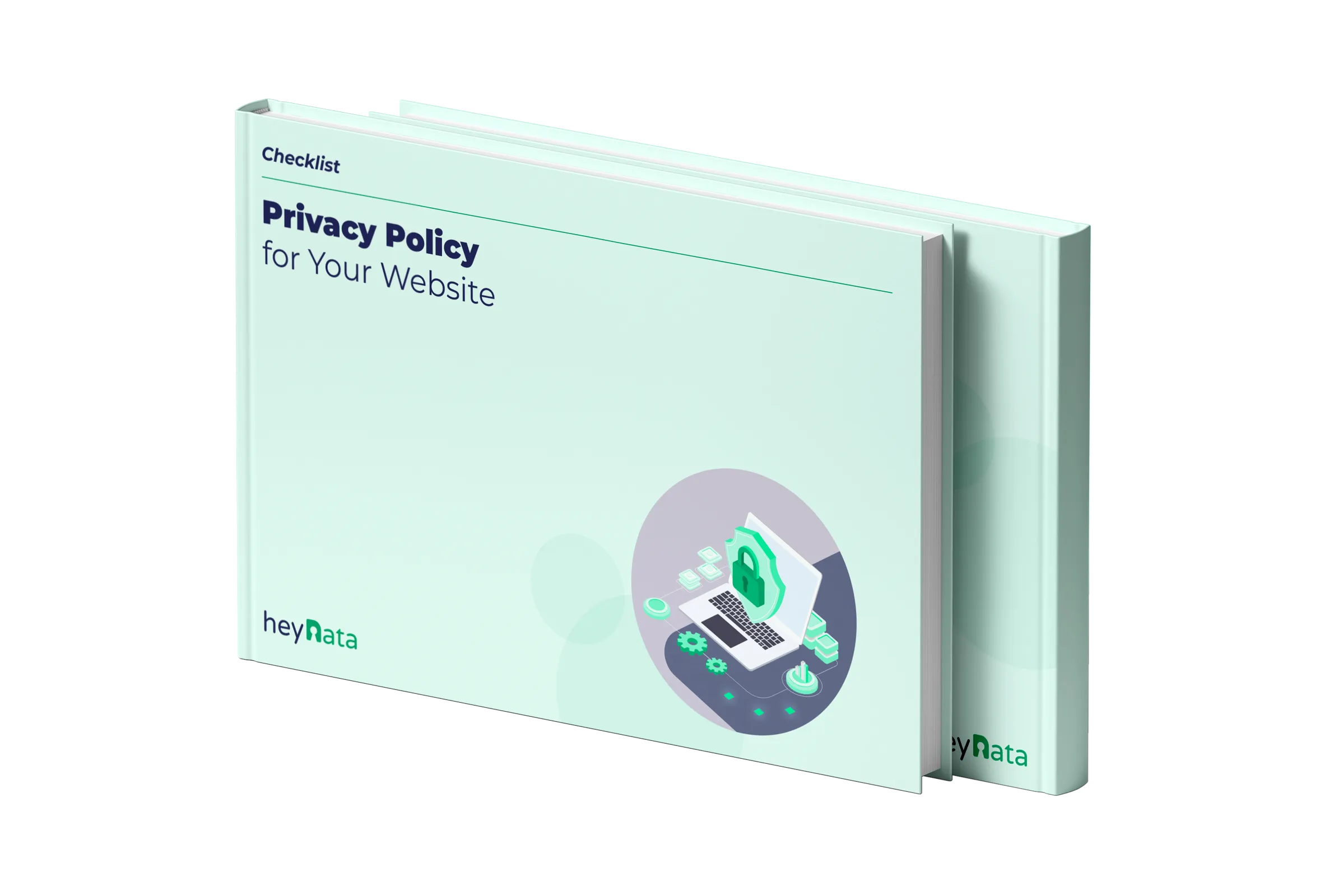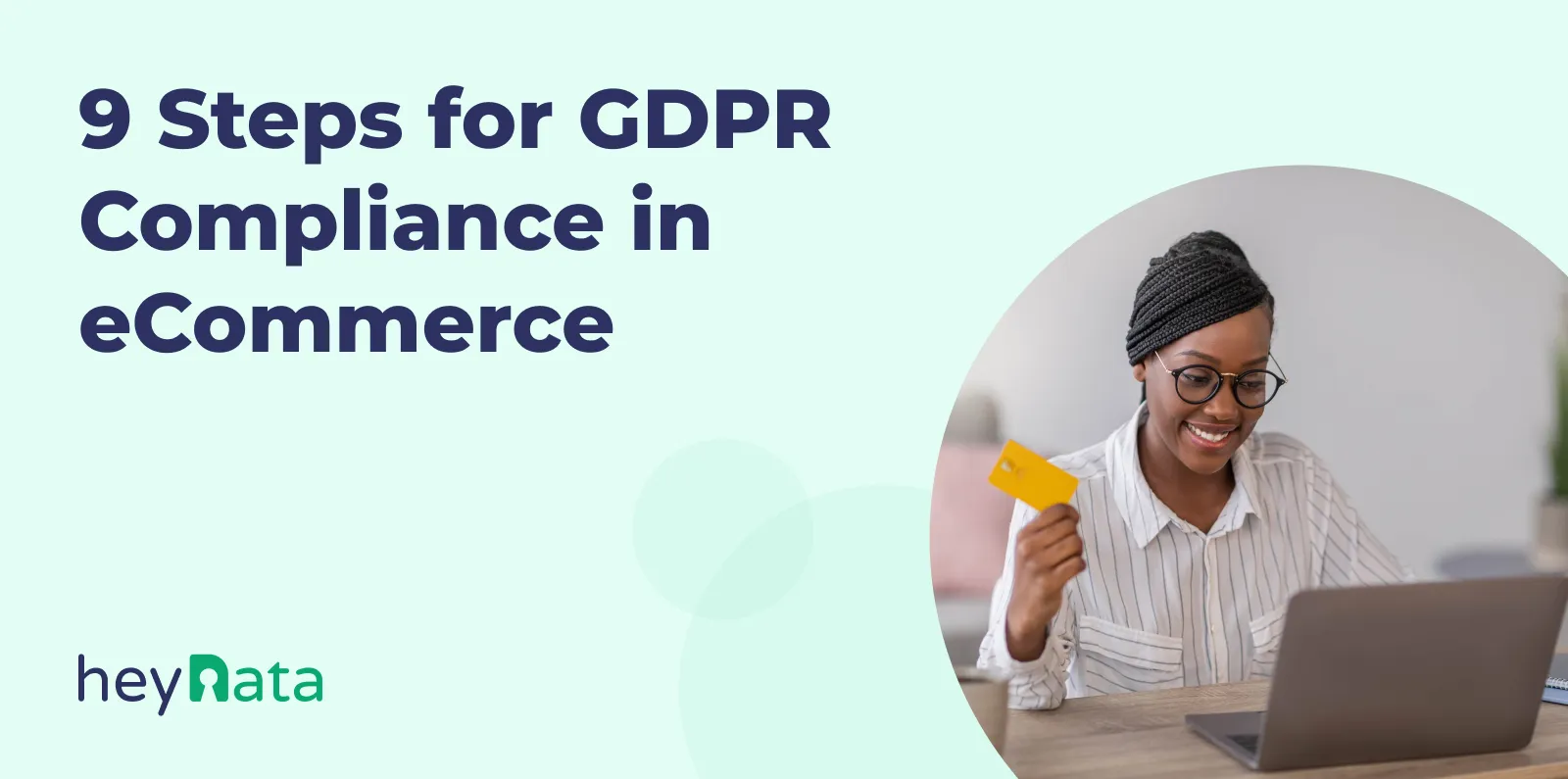
Get your free privacy policy checklist!
Our free checklist will help you cover all the important aspects of the privacy policy!

9 Steps for GDPR Compliance in eCommerce

For e-commerce businesses, GDPR compliance is more than a legal obligation — it’s a necessity.
E-commerce businesses process vast amounts of personal data, from payment details to browsing behaviors, making robust data protection measures critical. Beyond ensuring legal compliance, embracing GDPR offers significant benefits:
- Targeted Marketing: GDPR compliance makes your marketing more efficient by focusing on users who willingly share their data, signaling genuine interest in your offerings. This is especially true for email marketing, where opt-in subscribers create a high-quality contact list. By targeting an engaged audience, you can save significantly on marketing costs while boosting effectiveness.
- Enhanced Brand Reputation: A compliant business can use positive customer feedback to improve its brand image, resulting in organic growth through referrals.
- Mitigation of Fraud Risks: Businesses can reduce the risks associated with data breaches and fraudulent transactions by ensuring proper data handling.
To achieve these benefits and avoid the risks of non-compliance, follow the 9 steps outlined in this guide.
Table of Contents:
1. Conduct a Data Audit
A comprehensive data audit is the first step towards GDPR compliance in eCommerce.
This process involves creating a personal data inventory to understand what data your business collects, how it is processed, and where it is stored. The key steps of a data audit include:
- Identifying Personal Data Collected: Determine all types of personal data collected from customers. This includes, for example, names, email addresses, payment information, and browsing behaviors.
- Assessing Current Data Processing Practices: Review how data is collected - this could include forms, cookies, or even third-party tools. Then, evaluate how this data is processed, used, and shared. Ensure all data processing activities adhere to GDPR principles such as purpose limitation and data minimization.
- Mapping Data Flows: Understand the journey of personal data within your organization. This includes identifying departments or individuals who have access to the data and any cross-border transfers.
- Evaluating Data Storage and Retention Policies: Analyze where personal data is stored and the security measures in place. Lastly, establish retention policies - decide how long to keep data and when to securely delete it.
By conducting a thorough data audit, you gain a clear understanding of your data practices and identify areas that need improvement to align with GDPR requirements.
Additionally, understanding the full scope of your data handling practices enables your eCommerce business to build stronger relationships with customers while safeguarding their information effectively.
Implement this step to lay a solid foundation for subsequent compliance efforts.
2. Update Your Privacy Policy
A concise, clear, and easy-to-understand privacy policy is an essential part of GDPR compliance in eCommerce. A privacy policy should cover:
- What data is collected: Specify all personal data gathered.
- Purpose of data collection: Explain why data is collected (e.g., order processing, marketing, customer service).
- How the data is used: Detail how customer data is processed and ensure all usage aligns with consent.
- Customer rights: Outline GDPR rights such as data access, rectification, and deletion.
A well-structured privacy policy not only ensures compliance but also builds customer trust. Make sure it is easily accessible and written in clear, straightforward language.
Learn more details about what should a privacy policy include.

Get your free privacy policy checklist!
Our free checklist will help you cover all the important aspects of the privacy policy!
3. Implement Consent Management
Obtaining explicit consent for data collection is a cornerstone of GDPR compliance in eCommerce. This includes:
- Cookie Consent Management: Ensure users can opt in or out of tracking cookies.
- Marketing Consent: Use clear opt-in mechanisms for email marketing and avoid pre-checked consent boxes.
- Consent Records: Maintain documentation of user consent to demonstrate compliance during audits.
This includes cookies, which play a crucial role in eCommerce by tracking customer behavior, personalizing the shopping experience, optimizing marketing efforts, remembering shopping carts as well as providing tailored product recommendations.
The simplest way to implement content management is by leveraging a consent management system. A consent management system has several functions:
- Collecting consent (e.g., via a cookie banner)
- Storing the consent records securely for compliance purposes, is vital in demonstrating compliance during audits
- Enabling users to manage or withdraw their consent at any time
- Ensuring that cookies and trackers are deployed granularly, according to user preferences
Popular consent management platforms include CookieYes, Usercentrics or consentmanager. These platforms help businesses streamline and automate the consent collection process while maintaining GDPR compliance.
4. Develop Strong Data Security Measures
Securing personal data is critical for eCommerce businesses, as the number of global cyberattacks keeps growing. Implementing robust data security measures can significantly reduce the risk of unauthorized access and data breaches.
To secure your data, start by implementing these strategies:
- Encryption: This process transforms sensitive information into a code to prevent unauthorized access. Encrypting data both in transit and at rest ensures that even if data is intercepted, it remains unreadable without the correct decryption key.
- Access Controls: Defining who has access to specific data is essential for protecting personal information. Role-based access controls (RBAC) should be established, limiting permissions based on job responsibilities. Regularly reviewing these access rights helps ensure that only authorized personnel have access to sensitive information.
- Regular Security Audits: Conducting frequent audits and vulnerability assessments identifies weaknesses in your security protocols. These assessments help in maintaining compliance with GDPR requirements, ensuring that your data protection strategies remain effective against evolving threats.
- Incident Response Plans: Prepare for data breaches with a structured response strategy.
Securing personal data is critical for eCommerce businesses, as the number of global cyberattacks keeps growing. Implementing robust data security measures can significantly reduce the risk of unauthorized access and data breaches.
By leveraging these strategies, you can create a security framework that protects customer data while maintaining GDPR compliance in your eCommerce operations.
5. Provide Comprehensive Staff Training
Effective GDPR compliance within your eCommerce business relies on well-trained employees. It's the responsibility of the employer to ensure that everyone who handles personal data is properly trained and follows data protection regulations.
Employees must understand GDPR and their implications on daily operations. This knowledge empowers them to handle personal data responsibly, reducing the risk of breaches.
Establishing an organization-wide commitment to data protection fosters accountability. Encourage staff at all levels to prioritize data security in their roles, promoting vigilance and responsibility when handling customer information.
Additionally, providing ongoing training sessions keeps your team informed about updates and changes in regulations. Regular workshops or compliance training courses can improve awareness and adapt practices accordingly.
This proactive approach enables your organization to respond effectively to any challenges related to personal data handling, safeguarding both customer trust and your business reputation.
6. Establish a Process for Data Subject Rights Management
Customer and data subject rights under GDPR are fundamental to ensuring privacy and protection in eCommerce. These rights include the right to access the personal data held about them, the right to correct the data, and the right to be forgotten, ensuring customer data is deleted upon request, among others.
Timeliness is crucial in addressing these requests. Documenting each request and the corresponding actions taken builds trust and transparency with customers. Compliance with GDPR mandates a response within one month, underscoring the importance of having a well-organized system in place.
Establishing efficient rights management processes involves:
- Designating a Data Protection Officer (DPO) or a responsible team to oversee data protection compliance and handle privacy-related matters within your organization.
- Establishing a channel for receiving requests, such as a dedicated email address or an online form
- Developing a standardized procedure for receiving, tracking, and responding to data subject requests within the required timeframe.
- Maintaining records of all requests as this documentation will be crucial during compliance audits
With these 4 steps, you can effectively manage and respond to data subject rights requests while maintaining GDPR compliance and building trust with your customers.
7. Review Third-Party Vendor Agreements
Establishing strong Data Processing Agreements (DPA) with third-party vendors is crucial for e-commerce businesses. These vendors, including payment gateways, marketing platforms, and cloud storage services, often handle sensitive personal data, which can result in significant compliance risks if not properly managed.
To manage risks related to third parties take these steps:
- Identify all third-party vendors that process personal data on your behalf
- Review existing vendor agreements to ensure they include appropriate GDPR provisions
- If necessary, negotiate amendments to the agreements to align them with GDPR requirements
- Regularly monitor and assess the compliance of your vendors with their obligations under the agreements
- Consider implementing contractual clauses that require vendors to promptly notify you of any data breaches or incidents
By taking these proactive steps, e-commerce businesses can minimize the risk of non-compliance and ensure that their customers' data is handled securely throughout its lifecycle.
Implementing Vendor Risk Management tools can significantly aid in this process. With effective Vendor Risk Management, you can quickly and reliably check all services and providers used for compliance with the GDPR, thereby minimizing risks associated with third-party vendors.
8. Appoint a Data Protection Officer (DPO)
It is mandatory according to GDPR to appoint a Data Protection Officer (DPO) for organizations that "process large-scale personal data as their core business activity or regularly monitor data subjects systematically and on a large scale."
Having a dedicated DPO enhances accountability and reinforces the importance of data protection within the organization. This position helps cultivate a culture that prioritizes customer trust and compliance, which is essential in today’s data-driven marketplace.
Responsibilities of a DPO include:
- Monitoring Compliance: Overseeing adherence to data protection laws and internal policies.
- Advising Management: Guiding data protection impact assessments and necessary measures.
- Acting as a Liaison: Serving as the point of contact for data subjects and regulatory authorities.
Investing in a knowledgeable DPO is vital for maintaining robust GDPR compliance efforts while safeguarding customer data. If hiring an internal DPO seems challenging, consider opting for an external data protection officer, which can provide safe and competent GDPR support. An external DPO can help your business become GDPR-compliant in just a few steps, eliminating the need for extensive training and reducing costs associated with recruiting and retaining a full-time DPO.
Ultimately, having a DPO, whether internal or external, ensures that your organization is proactive in protecting personal data, fostering trust with customers, and avoiding fines for non-compliance.
9. Prepare a Response Plan
Not having a breach response plan in place can have devastating consequences, both financially and reputationally. In the unfortunate event of a data breach, an immediate and well-orchestrated response is crucial.
It is mandatory under GDPR to notify the data subjects and the supervisory authority within 72 hours of becoming aware of a data breach unless it is unlikely to result in a risk to individuals' rights and freedoms. Failure to comply with this requirement can result in significant penalties.
A comprehensive response plan should include:
- Clear roles and responsibilities for each team member involved in the response process.
- A step-by-step guide outlining the actions to be taken in the event of a breach.
- Communication protocols to ensure timely and accurate notifications to affected individuals, regulatory authorities, and other stakeholders.
- Procedures for containing and mitigating the breach, including identifying the root cause and implementing necessary remedial measures.
By proactively preparing a response plan, your e-commerce business can minimize the impact of a breach, demonstrate commitment to data protection, and maintain customer trust even in challenging times.
Conclusion
Achieving GDPR compliance for your e-commerce business might seem daunting, but with the right steps, it becomes a manageable and rewarding process.
By following the 9 steps outlined in this guide, you can establish a strong foundation for compliance and customer trust.
Remember, GDPR compliance doesn’t have to be hard. Tools like heydata’s All-in-One Compliance Solution simplify the process, offering a streamlined way to meet regulatory requirements while focusing on what you do best—growing your business. Take the first step today and make compliance an integral part of your e-commerce success story.
Important: The content of this article is for informational purposes only and does not constitute legal advice. The information provided here is no substitute for personalized legal advice from a data protection officer or an attorney. We do not guarantee that the information provided is up to date, complete, or accurate. Any actions taken on the basis of the information contained in this article are at your own risk. We recommend that you always consult a data protection officer or an attorney with any legal questions or problems.


